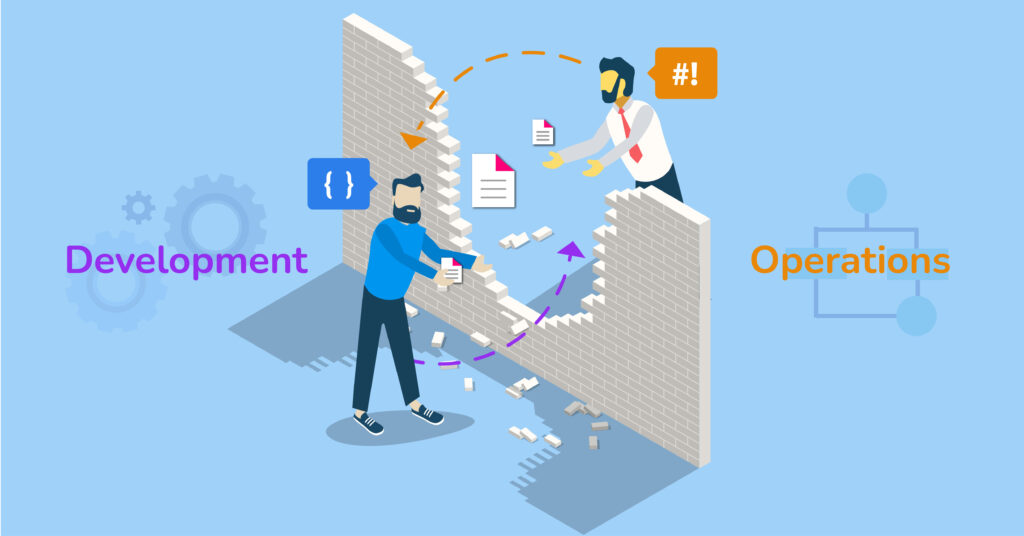Table of Content
DevOps Practices for Organizational Success 2022
How does DevOps create competitive strength? Enterprises’ competitive strength requires the right digital capabilities to sustain innovation and operational excellence over a long period of time. DevOps practices can be adopted by all types and sizes of organizations and are vital in this age of software. DevOps transformations are facilitated by business leadership, a true collaboration of expertise, and leveraging of the right technologies.
DevOps Explained
DevOps are the digital capabilities, practices, and management of processes adopted by teams of operations and development (DevOps) working together across the application lifecycle to gain operational performance. DevOps teams transform their processes and deliver applications consistently at high velocity, adding value that accumulates over time and is hard to replicate.
DevOps Best Practices
Improving operations consistently over time permits enterprises to adapt and master the abilities necessary to operate efficiently and effectively with the technical expertise to develop products using the latest technologies. DevOps’ best practices help reach goals such as improving user experiences, reducing costs, and increasing product innovation.
DevOps operating activities focus on specific capabilities to develop products in sync with cultural norms, management styles, modern operational practices, and organizational structures.
A DevOps organization has development teams and operations teams that communicate and collaborate while sharing information, responsibilities, and workflows in order to transform the software delivery process and propagate it across multiple business areas. DevOps teams are responsible, accountable, and focused on solving end-user needs.
DevOps best practices automate and stream the software development process with synchronized cadence, delivering software iteratively in small increments through a Continuous Integration/ Continuous Delivery (CI/CD) pipeline to deploy code frequently.
DevOps engineers build the functionality around business capabilities by implementing a microservices architecture (loosely coupled architecture) to deploy services independently, maintaining compatibility with other components to enable the interaction of business functionality with external interfaces and to adapt products faster. Adapting to the needs of DevOps practices sometimes requires an incremental architecture migration.
Agile principles and practices enable DevOps to manage the organization’s sharing of goals throughout the value stream to align product managers, architecture, operations, development, and security. DevOps practices promote the implementation of testing and security practices early in the development cycle to avoid bottlenecks in production that could affect the product quality.
IT operations create reliable, stable, and secure systems that enable developers to code and implement user features while ensuring their work flows through the value stream, maximizing productivity. Shorter cycles, continuous experimentation, and implementation routines of features result in higher quality products and faster time to market.
DevOps practices ensure that organizations can keep systems working reliably and responding quickly to changes. In addition, DevOps ensures that IT operations are managed effectively, with the same goals and incentives as the developers, in order to avoid friction and the accumulation of problems that impact customers or create more significant problems (i.e., technical debt). Thus, teams learn continuously through a feedback loop process during the development cycle and problems are fixed early.
DevOps teams become resilient through activities that simulate system failures, detect issues, restore systems, and prepare the organization for disaster recovery. Additionally, DevOps teams manage a telemetry framework that monitors operations and logging to ensure systems, applications, and environments are working correctly. Telemetry gathers information from the deployment pipeline that helps to detect conditions and guide problem-solving.
DevOps Practices and Benefits for Organizational Success
Adopting DevOps practices brings organizational success by improving software delivery performance and creating more robust applications and services.
- Improved software development capabilities—speed, stability, availability, and security
- Improved operational performance and reliability of software delivery—reliability metrics
- Faster lead times for changes—median lead time for taking code from commit to production (velocity)
- Faster deployment frequencies—the deployment of code to production and release to end-users successfully
- Faster time to restore services from incidents or defects—recovery from failures in production, outages, and service impairments
- Lowers change failure rate (changes to systems/services that require remediation)—ability to handle incidents (service outages and impairment) with patches, rollbacks, hotfixes, etc.
- Improved security outcomes—integration of security and compliance control into all stages of the development cycle
- Improved organizational performance—improving financials, productivity, customer satisfaction, and organizational metrics
- Increased engagement of IT operations, QA, and security in product development
- Higher employee satisfaction and improved environment—worker well-being avoids burnout
- Reduced organizational tension through a culture of psychological safety—build a safe environment by breaking chronic conflicts
- Reduced handoffs between development and operations
How to Implement DevOps Practices in Your Organization
The DevOps Journey
Organizations must build DevOps practices in phases. Begin by choosing the right individuals and teams to start the DevOps journey—as well as choosing the departments in which influencers and supporters who will offer the least resistance to change are found. This will ensure that the organization can experiment and learn while building credibility slowly in order to set the basis for expanding the DevOps practices to other areas.
Understanding the Value Stream
Leadership organizes and sets strategies to adopt DevOps capabilities, including a transformation plan model with clearly defined outcomes and a plan to scale the DevOps culture. DevOps teams work on understanding the value stream and how work is performed to deliver value to customers as well as identifying areas needing improvement and problems to solve.
Assemble DevOps Teams and Map the Value Stream
The next step is to identify the team members involved in creating value and understand how they create value. The DevOps team meets to discuss and document the product development process, from the business idea to UX research, UI/UX design, feature implementation, integration, testing, and deployment. The value stream illustrates the current processes, lead times, and problems. Finally, the teams input their observations and refine the value stream with the projected state and the required activities and tasks needed to move forward.
DevOps Practices Team Allocation
Enterprises must fight against old practices and internal bureaucracies that have been established for years and control the processes with much resistance to change, playing against the DevOps initiatives. Most organizations face this problem, and this is why many businesses opt for the creation of independent or external transformation teams.
Companies can create dedicated teams by allocating team members with the appropriate skills; it is often challenging to find talent with DevOps skills, however, as these are in high demand. Another solution to overcome internal resistance is outsourcing DevOps teams that align with company goals and change management needs in order to create new processes and experiment with DevOps practices.
DevOps practices enable independent, cross-functional teams with engineering skills that work to deliver features and deploy and run their code without dependencies (self-service). They manage their services in production while integrating other functional operations into the delivery process.
IT Operations Support Dev Teams
DevOps best practices show IT operations teams supporting development teams with tools that enable self-service. Operation engineers continually work to provide developers with standardized tools, platforms, and capabilities in order to make them more productive. In addition, ops engineers participate with product and dev teams to ensure their needs are integrated into operations, attending standups and other scrum events to gain visibility of development activities and to provide feedback about new learnings. Operations teams also create visibility of the relevant or necessary information for developers regarding product delivery, thereby helping to avoid failures.
Developers create on-demand production-like environments from version control systems to recreate production environments throughout the development cycle. IT operations create mechanisms that enable version control systems and self-service test environments within the value stream. Production-like environments allow developers to see how an app behaves daily and to test it before releasing it.
Production-like environments are created on demand and are self-servicing through an automated mechanism that defines the environment from a known environment, codifying and embedding its requirements into a build process. These production-like environments are consistent and synchronized to allow developers to create new reliable environments that reproduce the real environment and give control for building, running, and testing the application in a safe mode.
Environment configurations are saved in the version control repository so that they can be reproduced. Other dependencies, source codes, applications, scripts, tools, files, and artifacts might be required to roll back or recreate entire processes, applications, or environments. Version control systems play a key role in software development and DevOps as they provide visibility to the value stream (IT operations, development, QA, security, etc.). Environments are updated frequently, and changes in production are replicated in all environments and version control systems.
A code is considered complete once it runs in production-like environments, eliminating possible problems when deploying in production. Practicing deployments in pre-production environments reduces deployment risks, defects, and errors and keeps the code in a deployable state.
Automated Testing Practices and Deployment Pipeline
In practice, teams must build in small batches, integrate changes, and deliver on schedule. All code is analyzed before committing changes within the codebase. If errors are found, however, changes must be reversed by rebuilding dependencies and code changes committed to the repository. (This becomes difficult unless automated testing practices are in place).
Continuous integration practices guide developers to build and automate test suites to perform testing daily within their builds to fix problems quickly. Developers build a deployment pipeline for committing, testing, and integrating code and environments continuously and to trigger software testing (unit tests, acceptance tests, integration tests) to validate changes within the version control system.
The deployment pipeline infrastructure contains all the information about code builds, versions, environments, errors, test results, etc. Automated testing is the best way to avoid an accumulation of problems and technical debt. The cultural norms of DevOps practices indicate that when a build or test fails, the team stops introducing new changes until the bug is fixed.
Continuous Delivery
Developers keep a reduced batch size, checking their code frequently and deploying daily or weekly (deployment pace), thereby optimizing team productivity by avoiding problems of merging branches. The committed code passes the tests before it is merged with the main branch to avoid impacting other developers (trunk-based development). The deployment pipeline is kept in a deployable state and delivers code at any time without integration phases (continuous delivery).
Automated Deployment
DevOps practices prefer to keep a high deployment frequency and a small batch size to avoid accumulating changes between the code in deployment and production. Automating code deployment into production is a documented method that improves speed and reduces errors. The code deployment process starts by packaging a version of the code from version control, running through a test suite, and deploying it to a given environment. All details are recorded (telemetry) for security and compliance, and the code is pushed (deployed) to production. Then developers run tests to ensure the code is operating and integrated correctly and get feedback about its performance.
Improve Your DevOps Practices
Organizations sharing DevOps principles and practices have a mission of gaining velocity, reliability, maintainability, and efficiency to transform faster. You can keep track of your DevOps progress by measuring your enterprise software delivery performance and using the data to improve your DevOps practices and capabilities. In addition, you can measure and compare events/occurrences in your development environment, or changes after implementing new processes, tools, or testing methods, to help you become aware of your improvements.
Google’s DevOps Research and Assessment (DORA) team has created an open-source ETL pipeline (The Four Keys Pipeline) that automates the collection of DevOps data from your GitHub or GitLab (process inputs) and transforms it to DORA metrics, connecting and aggregating data to BigQuery via Webhooks, and providing a dashboard for visualization.
Organizations need DevOps teams to leverage capabilities and expertise in multi-cloud environments to improve the software delivery process and business outcomes. DevOps practices leveraging cloud computing capabilities can benefit with on-demand self-service, broad network access, elasticity, resource pooling, and measured services.












0 Comments